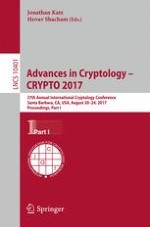2017 | OriginalPaper | Chapter
Be Adaptive, Avoid Overcommitting
Authors : Zahra Jafargholi, Chethan Kamath, Karen Klein, Ilan Komargodski, Krzysztof Pietrzak, Daniel Wichs
Published in: Advances in Cryptology – CRYPTO 2017
Publisher: Springer International Publishing
Activate our intelligent search to find suitable subject content or patents.
Select sections of text to find matching patents with Artificial Intelligence. powered by
Select sections of text to find additional relevant content using AI-assisted search. powered by
